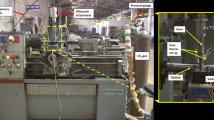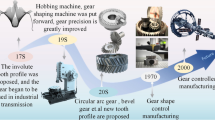Abstract
The functional behaviors and service performances of aeronautic gears are significantly determined by its surface integrity. Vibratory polishing, as one of the most promising ultra-high-precision finishing approaches for free-form surfaces, shows strong capability to improve the surface integrity of aeronautic gears. In order to gain a scientific insight into the surface generation, a three-dimensional predictive model is proposed in this study for the vibratory polishing surfaces of aeronautic gear considering the initial workpiece topography. The single abrasive particle is regarded as a micro-tool and the removed material is quantitatively determined based on the calculation of Brinell hardness. Then, the predictive model of the surface micro-topography can be developed on the basis of the initial workpiece topography and the interaction between workpiece and abrasive particles. The vibratory polishing tests are further carried out to verify the validity of the proposed surface topography prediction model. The results indicate that the predicted three-dimensional surface roughness agrees well with that of the measured data with an average error of 6.35%. Finally, parametric analysis is conducted to investigate the influence of polishing time, surface hardness, and abrasive particle diameter on the surface parameters. The preliminary work presented in this study is not only helpful to lay a scientific foundation for the more in-depth understanding of the surface generation and material removal mechanism in vibratory polishing, but also meaningful to provide an engineering guidance for the prediction of surface quality and optimization of machining parameters.
















Similar content being viewed by others
Data availability
The datasets or material used or analyzed during the current study are available from the corresponding author on reasonable request.
References
Gupta K, Mashamba A (2017) Hybrid finishing induced surface integrity of gears-a review. 15th International Conference on Manufacturing Research / 32nd National Conference on Manufacturing Research. Univ Greenwich, London, England
Li XH, Li WH, Yang SQ, Shi HT (2018) Experimental investigation into the surface integrity and tribological property of AISI 1045 steel specimen for barrel finishing. 4th CIRP Conf Surf Integr (CSI). Tianjin, Peoples R China
Zhang SJ, To S, Wang SJ, Zhu ZW (2015) A review of surface roughness generation in ultra-precision machining. Int J Mach Tool Manu 91:76–95. https://doi.org/10.1016/j.ijmachtools.2015.02.001
Xu YC, Zhang KH, Lu S, Liu ZQ (2012) Experimental investigations into abrasive flow machining of helical gear. 3rd Natl Conf Digit Des Manuf Technol (DDMTC 2012). Ningbo, Peoples R China
Shaikh JH, Jain NK (2014) Modeling of material removal rate and surface roughness in finishing of bevel gears by electrochemical honing process. J Mater Process Technol 214(2):200–209. https://doi.org/10.1016/j.jmatprotec.2013.08.010
Chang C, Ma Z, Yang SQ, Gao ZX, Liang GX (2021) Investigation into the surface integrity of crankshaft by barrel finishing. P I Mech Eng E-J Pro 235(6):2019–2026. https://doi.org/10.1177/09544089211026865
Bergs T, Muller U, Barth S, Ohlert M (2021) Experimental analysis on vibratory finishing of cemented carbides. Manuf Lett 28:21–24. https://doi.org/10.1016/j.mfglet.2021.02.004
Naeini SE, Spelt JK (2011) Development of single-cell bulk circulation in granular media in a vibrating bed. Powder Technol 211(1):176–186. https://doi.org/10.1016/j.powtec.2011.04.018
Zanger F, Kacaras A, Neuenfeldt P, Schulze V (2019) Optimization of the stream finishing process for mechanical surface treatment by numerical and experimental process analysis. CIRP Ann 68(1):373–376. https://doi.org/10.1016/j.cirp.2019.04.086
Bankowski D, Mlynarczyk P (2020) Visual testing of castings defects after vibratory machining. Arch Foundry Eng 20(4):72–76. https://doi.org/10.24425/afe.2020.133350
Hao YP, Yang SQ, Li XH, Li WH, Wang XZ (2021) Analysis of contact force characteristics of vibratory finishing within pipe-cavity. Granul Matter 23(2). https://doi.org/10.1007/s10035-021-01089-3
Hashimoto F, DeBra DB (1996) Modelling and optimization of vibratory finishing process. CIRP Ann 45(1):303–306. https://doi.org/10.1016/S0007-8506(07)63068-6
Uhlmann E, Dethlefs A, Eulitz A (2014) Investigation into a geometry-based model for surface roughness prediction in vibratory finishing processes. Int J Adv Manuf Tech 75(5):815–823. https://doi.org/10.1007/s00170-014-6194-8
Kim J-D, Choi M-S (1995) Simulation for the prediction of surface-accuracy in magnetic abrasive machining. J Mater Process Technol 53(3):630–642. https://doi.org/10.1016/0924-0136(94)01753-N
Cheung CF, Kong LB, Ho LT, To S (2011) Modelling and simulation of structure surface generation using computer controlled ultra-precision polishing. Precis Eng 35(4):574–590. https://doi.org/10.1016/j.precisioneng.2011.04.001
Savio G, Meneghello R, Concheri G (2009) A surface roughness predictive model in deterministic polishing of ground glass moulds. Int J Mach Tool Manu 49(1):1–7. https://doi.org/10.1016/j.ijmachtools.2008.09.001
Wang T, Zou L, Wan Q, Zhang X, Li Y, Huang Y (2021) A high-precision prediction model of surface roughness in abrasive belt flexible grinding of aero-engine blade. J Manuf Process 66:364–375. https://doi.org/10.1016/j.jmapro.2021.04.002
Zhou W, Tang J, Chen H, Zhu C, Shao W (2018) A comprehensive investigation of plowing and grain-workpiece micro interactions on 3D ground surface topography. Int J Mech Sci 144:639–653. https://doi.org/10.1016/j.ijmecsci.2018.06.024
Li M, Lyu BH, Yuan JL, Yao WF, Zhou FF, Zhong MP (2016) Evolution and equivalent control law of surface roughness in shear-thickening polishing. Int J Mach Tool Manu 108:113–126. https://doi.org/10.1016/j.ijmachtools.2016.06.007
Legido Pérez De San Román A, Chaves-Jacob J, Linares J-M, Arrazola PJ (2021) Analytical-method for polishing-surface prediction considering tool flexibility and grain-material interaction. J Mater Process Technol 295:117208. https://doi.org/10.1016/j.jmatprotec.2021.117208
Lu A, Jin T, Liu QF, Gun ZF, Qu MN, Lun H, Han M (2019) Modeling and prediction of surface topography and surface roughness in dual-axis wheel polishing of optical glass. Int J Mach Tool Manu 137:13–29. https://doi.org/10.1016/j.ijmachtools.2018.10.001
da Silva ML, Spelt JK (2018) Bulk mass flow in a vibratory finisher: mechanisms and effect of process parameters. Granular Matter 20(3):57. https://doi.org/10.1007/s10035-018-0830-1
Wang D, Ge P, Bi W, Jiang J (2014) Grain trajectory and grain workpiece contact analyses for modeling of grinding force and energy partition. Int J Adv Manuf Tech 70(9):2111–2123. https://doi.org/10.1007/s00170-013-5428-5
Leyi G, Wei Z, Jing Z, Songling H (2011) Mechanics analysis and simulation of material Brinell hardness measurement. Measurement 44(10):2129–2137. https://doi.org/10.1016/j.measurement.2011.07.024
Kang YS, Hashimoto F, Johnson SP, Rhodes JP (2017) Discrete element modeling of 3D media motion in vibratory finishing process. CIRP Ann 66(1):313–316. https://doi.org/10.1016/j.cirp.2017.04.092
Funding
This work was supported by the National Key R&D Program of China (Grant No. 2020YFB2010200), the National Science and Technology Major Project (2017-VII-0003–0096), the Defense Industrial Technology Development Program (No. JCKY2020213B006), and the National Key Laboratory of Science and Technology on Helicopter Transmission (Grant No. HTL-0-21G04).
Author information
Authors and Affiliations
Contributions
SW: software, data curation, conceptualization, methodology, original draft preparation; YH: conceptualization, investigation, data curation, writing—review and editing; JT: data curation, writing—review and editing; QL: writing—review and editing; HD: conceptualization, methodology, investigation, writing—review and editing; ZL: writing—review and editing.
Corresponding author
Ethics declarations
Ethics approval
Ethical approval is not required for this study.
Consent to participate
Not applicable.
Consent for publication
Manuscript is approved by all authors for publication.
Conflict of interest
The authors declare no competing interests.
Additional information
Publisher's note
Springer Nature remains neutral with regard to jurisdictional claims in published maps and institutional affiliations.
Rights and permissions
Springer Nature or its licensor (e.g. a society or other partner) holds exclusive rights to this article under a publishing agreement with the author(s) or other rightsholder(s); author self-archiving of the accepted manuscript version of this article is solely governed by the terms of such publishing agreement and applicable law.
About this article
Cite this article
Shao, W., Hou, Y., Tang, J. et al. On the predictive modeling of surface micro-topography in vibratory polishing of aeronautic gear considering initial workpiece topography. Int J Adv Manuf Technol 126, 1553–1565 (2023). https://doi.org/10.1007/s00170-023-11134-5
Received:
Accepted:
Published:
Issue Date:
DOI: https://doi.org/10.1007/s00170-023-11134-5




